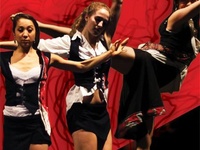Given the pure scale and complexity of “Momentum,” it is easy to forget that the show is run entirely by full-time students whose responsibilities match those of any other undergraduate on campus.
“It’s definitely a challenge when you bring in professional choreographers like Josie Walsh who are used to working with dancers who rehearse eight hours a day for a living,” Walker says regarding the difficulty of rising to HBC’s professional dance standards while balancing a full course load and other commitments.
“Since the choreographers are used to such a high level of talent, we really feel like we have to be on top of our game,” Walker continues, pointing out that the short residency of most guest choreographers often necessitates a grueling sequence of six-hour rehearsals on weekends that spill into four-hour sessions on weekdays. Two Sundays ago, Company members remained at the Loeb from 9 a.m. to 9 p.m., going home exhausted and sore after a marathon session of hanging lights and setting up the theatre.
With days as long as these, excelling in both school and dance becomes a challenge. “[It is] incredibly difficult to keep my body in good shape for dance when [I] am forced to replace ballet technique class with last-second problem sets or papers,” says Kevin Shee ’11, who has danced professionally but plans to pursue a medical career.
Still, Shee believes the benefits of dancing with HBC are well worth the physical and academic sacrifices. “It’s been hard on my body, but it really makes me appreciate the joy that comes with every dance step–it makes all those late nights more bearable,” Shee says.
Co-performer Samantha C. Cohen ’12 (who is also a comper on The Crimson’s arts board) echoes this sentiment, citing the value of bonding with fellow dancers, working with world-class choreographers and staging state-of-the-art performances. “It can definitely get a little stressful during intensive rehearsals, especially... as it gets closer to performance time,” she says, “but in the end, those are the amazing experiences that we get to share as a company.”
THE TIPPING POINTE
Though members of HBC balance their commitments as students and dancers gracefully, there are inherent limits to what they can achieve at a liberal arts college with little curricular focus on dance.
“[HBC] is run by students, so they try and work really hard,” Bergmann says. “But they’re also trying to study; they have another concentration.”
The Harvard Dance Program, also limited to the extracurricular realm, shares similar constraints. “I think our Harvard students come in and are very prepared and smart so they can pull it off,” says Bergmann, who is not considered a full-fledged faculty member. “But at administrative levels there’s no faculty representation. I’m not privy to the decision making here in dramatics, theater and dance. We don’t have a voice at the table. And we need one. We’re still an extracurricular activity and viewed that way and not as important as a field study.”
For Bergmann, until dance achieves a status equal to academic departments on campus, the program, despite its improvements, will stagnate. “I think we’ve gone as far as we can go until we move into more curricular focus,” she says.
But back at Kuperman’s rehearsal, curricular reform is far from the dancers minds. Getting ready for a full run-through of the piece, they focus their energy on delivering a performance that effectively conveys the choreographer’s artistic concept and exceeds the standards upheld by the Company.
Shee tries a hands-free cartwheel, primarily to get his blood flowing again and secondarily to entertain his fellow dancers, whose movements maintain a hint of grace even as they laugh and make fun of their own mistakes.
The music begins, heightening as each of the “statues” is brought to life with powerful “fouette” jumps and fluid promenades on black boxes-turned-platforms. The subdivisions of the beat are inaudible, but the dancers move with a rhythmic cohesion built on a collective understanding of musicality and awareness of each others’ bodies.
Shee comes to life with a triple piourette into a few more turns in “coup de pied,” tacking on a double tour jump just for kicks. The other dancers flood center stage and crowd around him, relegating Kuperman’s frustrated character (the sculptor) to stage right.
Though at this moment the choreographer stands off to the side, there are hopes that his work, and all others featured in “Momentum,” will bring dance into the spotlight at Harvard.
“Will we get more money? Will we get more courses in dance? I don’t know,” Bergmann says of the show’s potential ramifications. “That depends on who comes, who might get influenced, who has a voice. I think that we can hope for some changes.”
—Staff writer Monica S. Liu can be reached at msliu@fas.harvard.edu.










